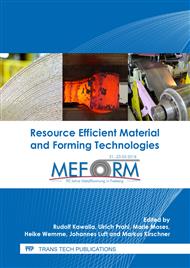p.85
p.95
p.103
p.110
p.117
p.125
p.134
p.140
p.145
Experimental Investigations of Bulge Formation for Burnishing on Plain Surfaces
Abstract:
Burnishing as a forming finishing process enables the production of precise and mechanical compressed surfaces. The forming operation can be easily integrated into cutting processes due to its kinematic similarities. Through this integration it was possible to create highly efficient process chains for the machining of rotational symmetrical parts. The formed surface qualities are also interesting for prismatic geometries, but the adaptation of this force controlled process is challenging, because of its multiaxial characteristics. A main limiting factor for burnishing on plain surfaces is the formation of a burnishing bulge on the edges of the burnished area. Several investigations of the process on plain surfaces where done to analyse the bulge formation characteristics of the aluminium EN AW-2007 material. Experiments of different single burnished paths and burnished areas with the subsequent 3D capturing of the created surfaces were done. The investigations show, that the deformation is highly dependent on the applied burnishing force and the burnishing feed. The length and width of the burnished area does not have an influence on the bulge formation.
Info:
Periodical:
Pages:
117-122
Citation:
Online since:
March 2018
Authors:
Keywords:
Permissions:
Share:
Citation:


